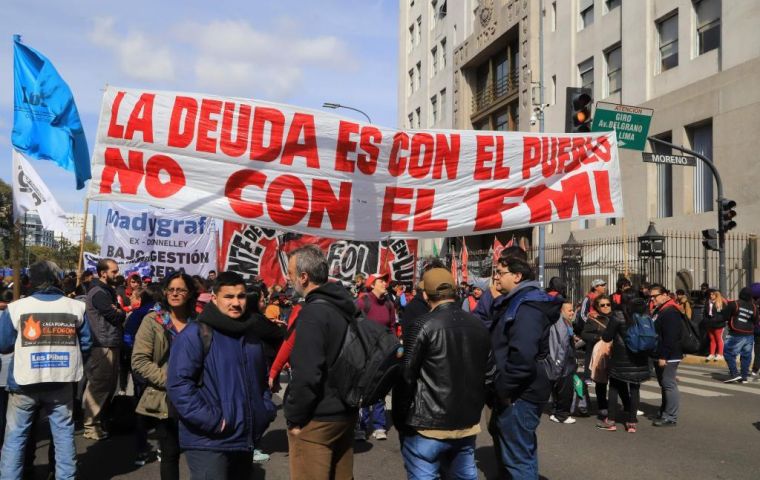MercoPress. South Atlantic News Agency
Argentine gross public debt stands at US$ 337.367 million; 2020 repayments sum US$ 44.232 million
 The information released in the web site of the Secretariat mark an increase of US$ 10,1 billion with a greater share from the IMF and a slight drop in the Central bank participation.
The information released in the web site of the Secretariat mark an increase of US$ 10,1 billion with a greater share from the IMF and a slight drop in the Central bank participation. Argentine gross public debt climbed 3% at the end of the second quarter of the year and has reached US$ 337.367 million compared to US$ 327.166 million in the same period last year, according to the Financial Secretariat.
The information released in the web site of the Secretariat mark an increase of US$ 10,1 billion with a greater share from the International Monetary Fund and a slight drop in the Central bank participation.
Likewise the office headed by Santiago Bausilli published the chronogram of maturing papers and repayments for next year, according to the following list:
January, US$ 2.419 million; February, US$ 2.955 million; March, US$ 3.041 million; April, US$ 9,971 million; May, US$ 10.617 million; June, US$ 4.565 million; July US$ 1.661 million; August, US$ 208 million; September, US$ 531 million; October, US$ 3.581 million; November US$ 3.178 million and December, US$ 1.325 million.
This adds up to US$ 44.232 million to be repaid next year, short and medium term. The list does not include repayments to the IMF and its US$ 57 billion standby loan since they begin 2021.
In June 2018, the Argentine government signed the standby accord with the IMF, and the first outlay reached US$ 14.911 million, but it was later expanded, and now stands at US$ 38.94 billion with a next check expected sometime this month.
One of the conditions of the IMF loan was that the central bank ceased to finance the Treasury, which had to implement strict austerity measures to ensure tax revenue. Thus the so called transitory advances to the Treasury dropped from US$ 7 billion last year to only US$ 1.1bn last June.




Top Comments
Disclaimer & comment rules-

-

-

Read all commentsMy dear friend, your lack of timing and or general knowledge about recent pop culture is surprising.
Sep 10th, 2019 - 06:39 pm +2Notice how I strategically used the “next” keyword preceding my mention of “government”.
You keep barking at parked cars.
My day is kind of slow today so it's great that you showed up. Hours of fun!!
Not necessarilly Jonaz. Once the elections are over, if the next government plays its cards well, we'll still be struggling next year but counting with some growth. The current crisis is a chance to clean up a few things (.i.e: BCRA short term liabilities, interest rates, dollar rate).
Sep 10th, 2019 - 02:46 pm +1Of course that all depends on how politicians behave during this month and a half.
Wake me up when October ends.
Ok, so we'll have an open default by April/May 2020. Good to know.
Sep 10th, 2019 - 11:43 am 0Commenting for this story is now closed.
If you have a Facebook account, become a fan and comment on our Facebook Page!